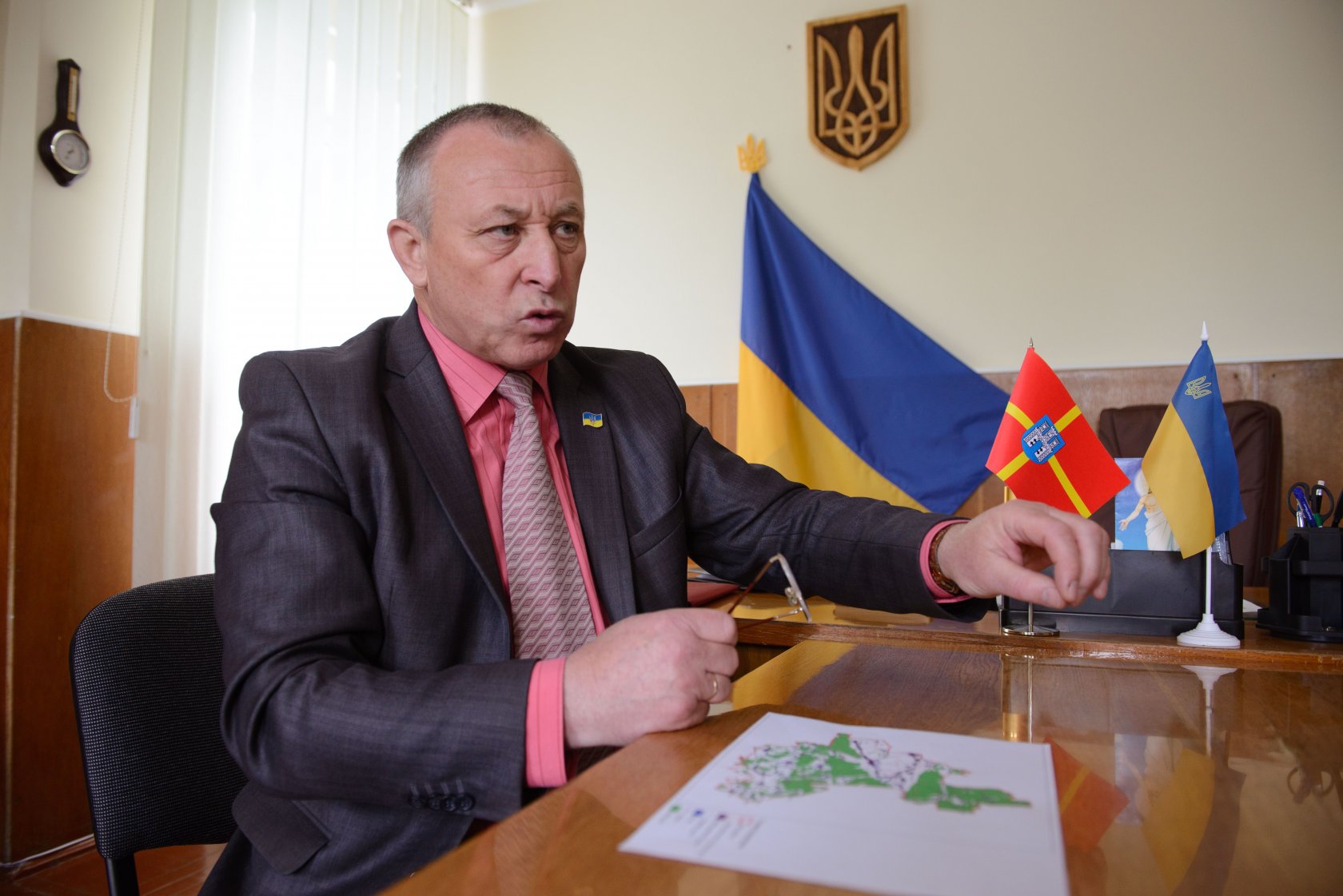Fondation Hirondelle // Ukraine project
"Old Attitudes
have to change"
In the Zhytomyr region, the newly decentralized communities multiply projects but still face old mentalities and a lack of responsibility
TEXT : JULIA MENDEL (with GAETAN VANNAY) - PHOTO & VIDEO : OLGA IVASHCHENKO
In Narodytchi, Laski and Nova Borova (Zhytomyr)
When we first meet Anatolii Leonchuk, the head of the Narodychi territorial community, he is in a passionate discussion with a local activist. The debate is around a small company that has been illegally constructed on the land of a former Soviet farm. The villager's goal is to close the business at any cost because of its environmental threat.
Leonchuk sighs. A local politician, he is the town's jack-of-all-trades. He was recently appointed head of the newly created community (Hramada) under the decentralization laws, but he is still in charge of the old Narodychi district, called a raion, which will soon disappear. At least officially on paper, since the law doing away with raions has not yet been adopted. "It's a little complicated," admits Leonchuk.
In front of the angry villager, Leonchuk doesn't give in. This is a legal matter and it is important to support economic activities. "This company creates jobs," he argues. In Narodychi today, youth unemployment is near 11 percent. But the cause of the dispute goes deeper. Since the decentralization process started, the population has taken an interest in having more of a say, "but people do not want to take responsibility for making decisions," regrets Anatolii Leontchouk.
In front of the angry villager, Leonchuk doesn't give in. This is a legal matter and it is important to support economic activities. "This company creates jobs," he argues. In Narodychi today, youth unemployment is near 11 percent. But the cause of the dispute goes deeper. Since the decentralization process started, the population has taken an interest in having more of a say, "but people do not want to take responsibility for making decisions," regrets Anatolii Leontchouk.
The Narodychi territorial community belongs to the region (Oblast) of Zhytomyr, a medium-sized city located about 170 kilometers from Kiev. Narodychi is one of the largest among the 159 new administrative entities (Hramada) formed in late 2015 as part of the decentralization law. It brings together 17 small rural communities and has approximately 10,000 inhabitants for a territory of 1,286 square kilometers.
But the region has an important defining feature: located 70 km east of Chernobyl, Narodychi is the western gateway to the no-go zone surrounding the nuclear power plant. After the explosion in 1986, Narodychi was among the areas most affected by radiation, with its population of 35,000.
Four villages in the surrounding areas were included in this no-go zone, while Narodychi remained in a secondary contaminated zone. In 1991, two-thirds of the district's inhabitants left, and those who remain are barely tolerated by the government.
But the region has an important defining feature: located 70 km east of Chernobyl, Narodychi is the western gateway to the no-go zone surrounding the nuclear power plant. After the explosion in 1986, Narodychi was among the areas most affected by radiation, with its population of 35,000.
Four villages in the surrounding areas were included in this no-go zone, while Narodychi remained in a secondary contaminated zone. In 1991, two-thirds of the district's inhabitants left, and those who remain are barely tolerated by the government.
"People's mentalities have to change in parallel with decentralization. Money will never be enough if mentalities don't change."
— Anatolii Leontchuk
— Anatolii Leontchuk
Reviving the region despite the possibility of remaining radioactivity is the local authorities' main goal. In line with its size and population, the Hramada of Narodychi has been promised central government aid to the tune of 22 million hryvnias (about 800,000 euros) for local projects: construction and maintenance of roads, renovation of schools and other community facilities that have fallen into ruin since the end of the Soviet period.
"There are small villages with less than a hundred inhabitants. They had no budget, they couldn't generate any revenue, they couldn't carry out any projects, Anatolii Leonchuk explains. Now we can identify priorities and provide the budget needed," he says. The state plans to financially support these local communities for the first five years until they are strong enough to support themselves.
"There are small villages with less than a hundred inhabitants. They had no budget, they couldn't generate any revenue, they couldn't carry out any projects, Anatolii Leonchuk explains. Now we can identify priorities and provide the budget needed," he says. The state plans to financially support these local communities for the first five years until they are strong enough to support themselves.
However, some residents are cautious about these reforms, as there is little understanding of the decentralization process. And they want to see results quickly. Volodymyr Petruk, head of a local cultural center in the remote village of Laski, is one of the optimistic ones. He has been managing the cultural center for 25 years and has witnessed how a historical landmark can turn to ruins. We enter the main hall through a stage that once hosted orchestras and concerts to see a huge hole in the ceiling and hear that the floor is too rotten to walk on.
But this is only one part of the building: There is also a museum, a library, dance halls and office space. Everything has fallen into decay since the Soviet Union collapsed. Surprisingly, these ruins still host up to a hundred people for dance parties three times a week. "Last year, it was the most popular place in the region," says Volodymyr. "I really hope that decentralization will let us find the money needed to repair the building. We have to hope."
But this is only one part of the building: There is also a museum, a library, dance halls and office space. Everything has fallen into decay since the Soviet Union collapsed. Surprisingly, these ruins still host up to a hundred people for dance parties three times a week. "Last year, it was the most popular place in the region," says Volodymyr. "I really hope that decentralization will let us find the money needed to repair the building. We have to hope."
Another Zhytomyr community, Nova Borova, also hopes to benefit from decentralization. It has already proposed a set of projects totaling 110 million hryvnias ($4.4 million), but from decentralization reform they are only set receive 4.7 million hryvnias ($188,000). Although its population is almost the same in size as Narodychi, its territory covers only 210 square kilometers. The small size of this hramada justifies its smaller budget, but like others the Nova Borova territorial community has an advantage in fundraising for other projects.
"Our integration into a territorial community opens a lot of doors. Bureaucrats in Kiev look at us differently if we are a united community and it gives us access to other existing funding that is off limits for smaller entities. For example, this year, the regional development fund will give us 7 million hryvnias ($280,000) to improve the insulation at a local school" explains Hryhorii Rudiuk, head of the Nova Borova community.
Projects such as the insulation of schools and kindergartens or the transition to alternative heating are the priorities in most new territorial communities in the Zhytomyr region. They are hoping to save money by becoming less dependent on Russian gas, the price of which can vary greatly depending on the political and geopolitical context. Hryhorii Rudiuk proudly shows us the school whose windows will finally be changed. This investment will save one million hryvnias per year (around 36,000 euros) and will keep the classrooms a few degrees warmer during Ukraine's cold winters.
"Our integration into a territorial community opens a lot of doors. Bureaucrats in Kiev look at us differently if we are a united community and it gives us access to other existing funding that is off limits for smaller entities. For example, this year, the regional development fund will give us 7 million hryvnias ($280,000) to improve the insulation at a local school" explains Hryhorii Rudiuk, head of the Nova Borova community.
Projects such as the insulation of schools and kindergartens or the transition to alternative heating are the priorities in most new territorial communities in the Zhytomyr region. They are hoping to save money by becoming less dependent on Russian gas, the price of which can vary greatly depending on the political and geopolitical context. Hryhorii Rudiuk proudly shows us the school whose windows will finally be changed. This investment will save one million hryvnias per year (around 36,000 euros) and will keep the classrooms a few degrees warmer during Ukraine's cold winters.
By heating the school in Nova Borova with wood, Hryhorii Roudiouk saves several thousand Euros, keeps the school warmer, and gains a bit more independence from Russian gas.
Understandably, the new heads of these communities are enthusiastic. In Nova Borova for example, the community needs a garbage truck, an ambulance, a football field, but most of all a new fire engine. Hryhorii Rudiuk just returned from a trip to Poland where he studied how decentralization works. During his time there, Polish colleagues offered a much needed fire engine and negotiations with the Polish town are nearly complete. Overflowing with excitement, Hryhorii shows us photos of the Polish fire engine on his smartphone, and then compares them with their 30 year old truck, patched up by local volunteers, that is currently being used. It's difficult to compare!
Such local initiatives are becoming more frequent: People are starting to take care of their environment, clean up their towns, and take care of buildings and local property. In a country where Soviet mentalities are still deeply entrenched, increasing individuals' responsibility is the best thing decentralization can bring.
Such local initiatives are becoming more frequent: People are starting to take care of their environment, clean up their towns, and take care of buildings and local property. In a country where Soviet mentalities are still deeply entrenched, increasing individuals' responsibility is the best thing decentralization can bring.

Anatolii Leonchuk looks at a map of his territory
Hryhorii Rudiuk and Anatolii Leontchouk agree: changing mentalities is not easy. In their view, bringing about tangible results is the only way to convince the population of decentralization's benefits.
Later, before heading back to his office in Narodychi, Anatolii Leontchouk drives along the narrow strip of road that is still intact, avoiding the numerous potholes full of rain, and sighs: "People's mentalities have to change in parallel with decentralization," he believes. "Money will never be enough if mentalities don't change. If they evolve, we can do a lot even without money."
Later, before heading back to his office in Narodychi, Anatolii Leontchouk drives along the narrow strip of road that is still intact, avoiding the numerous potholes full of rain, and sighs: "People's mentalities have to change in parallel with decentralization," he believes. "Money will never be enough if mentalities don't change. If they evolve, we can do a lot even without money."

